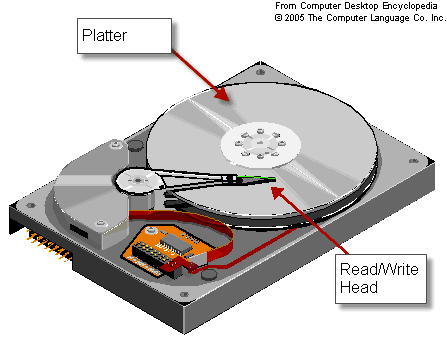
Keeping clients' computers safe and profitable for over 30 years
Home Forms About Current Newsletter subscribe
Search All Articles
Browse by Category

SSD Drives
Most of the systems I'm selling now do not have normal spinning hard disk drives in them at all! They store their data on Intel SSD drives. The Intel drives are supposed to be the most reliable. SSD stands for solid-state drive. It stores the data on flash memory chips.
Normal hard disk drives (HDD) store information magnetically on spinning platters.

The picture above illustrates how a normal hard disk drive looks. There are multiple platters which spin about 7200 RPM and the moving head reads and writes the data magnetically. So the motor needs to spin it, the magnetic head needs to find the exact correct spot and physically move there and perform the write operation. It is conceptually patterned off of old phonograph records.
SSD drives by contrast have no moving parts. Everything is memory. This results in a much more reliable drive (though current hard disk drives are incredibly reliable), it also survives physical shocks better (making them great for notebooks and tablets). They consume very little electricity, are much faster and are silent. They also produce less heat, reducing the need for cooling. What end users notice most, is their speed. Boot times are much faster, and everything in and out of the drive occurs much more quickly.
SSD drives do wear out because the media can only be written to about 100,000 times in each memory location. As a result, complex code runs on the drives to level the writing throughout the drive's memory. The Intel drives come with an Intel tool which allows you to determine how much of the lifetime of the drive you've used. It also recommends tuning once a week. Expect your drives to last about 10 years, or twice the life expectancy of normal hard disk drives. When the drive approaches its end of life, the drive's brain disables writing. You will not lose any data and can retrieve all of it. It just won't let your write any more.
NEVER defragment an SSD drive. It won't do any good and will reduce the life span.
The problem with SSD drives is they cost more per Gigabyte. As a result, if someone stores lots of information (pictures, music, etc.) on their internal hard drive, SSD drives may not be a good solution. Mostly I sell 120 GB SSD drives into business settings. For clients who want the speed and reliability of the SSD drive and the capacity of HDD drives, I install both, putting the operating system and programs on the SSD drive and the data on the Hard drive.
Date: February 2012

This article is licensed under a Creative Commons Attribution-NoDerivs 3.0 Unported License.